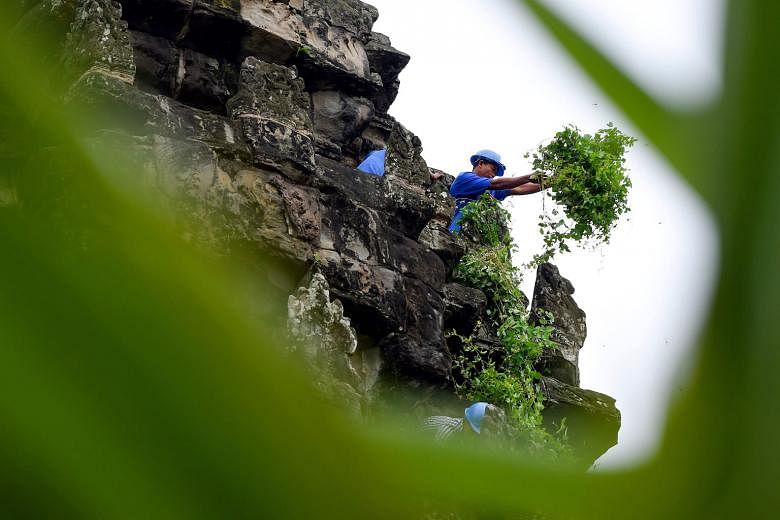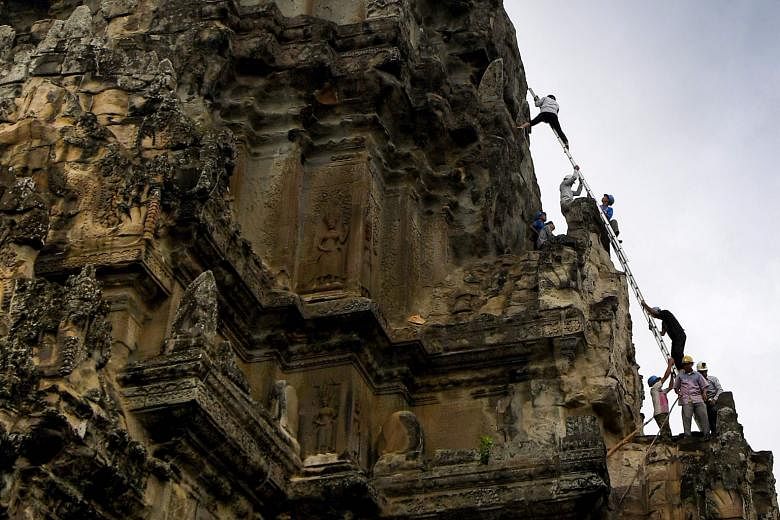SIEM REAP • Stacking a ladder against the towering spires of Cambodia's archaeological marvel Angkor Wat, Mr Chhoeurm Try gingerly scales the temple's exterior to hack away foliage before it damages the ancient facade.
The 50-year-old is part of a crack team of gardeners ensuring the kingdom's most valued heritage site is not strangled by overgrown tree saplings sprouting from the sandstone's cracks. For 20 years, he has made the treacherous climbs barefoot up to Angkor Wat's central tower, which rises 65m above the archaeological complex in the city of Siem Reap.
"If we make a mistake, we will not survive," Mr Chhoeurm Try said. But he soldiered on, aware that the fight to hack away tough roots is an ongoing battle against nature. "When the sapling trees grow bigger, their roots go deep and cause the stones to fall apart."
Preserving the dozens of temples at Angkor Archaeological Park is a delicate year-round job taken on by a 30-member team.
The world heritage site contains monuments from the 9th to 15th centuries, and was Cambodia's most popular tourist destination before the coronavirus pandemic paralysed global travel.
"If we don't preserve them... the younger generation would not get a chance to see them," Mr Chhoeurm Try said.
With hard hats as their only safety gear, the gardening team is used to performing their duties under the gaze of visiting tourists. "When local and international tourists see us climb up the temples, it seems scary to them and they think there is a lack of technique," said team leader Ngin Thy.
But using ropes or climbing gear is out of the question, as it could damage the fragile stone work, while scaffolding would take weeks to build and pull down.
There are also tight sections in certain temples that need workers to crawl through, navigating their way around jutting sculptures as they attempt not to unnecessarily come into contact with the friezes.
"At temples with brick work, the job is even more difficult," Mr Chhoeurm Try said, recounting a near miss a few years ago when a brick fell on his head and cracked his helmet into two.
A few local tourists and Buddhist monks gazed up in awe, admiring the gardeners' teamwork.
"They are so brave," said tourist Roth Veasna, holding his breath while watching a worker scale a ladder as his colleagues gripped it tightly.
Leaving the temples unmanicured could bring back the vision that French naturalist and explorer Henri Mouhot had encountered in the 1860s, when he chanced upon the site. It had been abandoned for centuries, its ancient stonework and carvings hidden under jungle growth.
Today, the officials of Apsara Authority - a government body managing the park - said they are searching for a liquid substance to eliminate root growth, so as to lessen the risks to the gardeners.
But "we need to experiment first because we are worried that it could also damage the stones when we pour it onto the roots", said deputy director Kim Sothin.
Until then, it is up to the nimble-footed gardeners to maintain the grandeur of Angkor Wat.
"Other people don't want to do this job because it is risky," said Mr Oeurm Amatak, 21, who joined the team a year ago. As an apprentice, he does not yet dare climb all the temples and his skill set is developing under the mentorship of his more experienced colleagues.
"You really have to love it, it's not for everyone," he said.
AGENCE FRANCE-PRESSE


